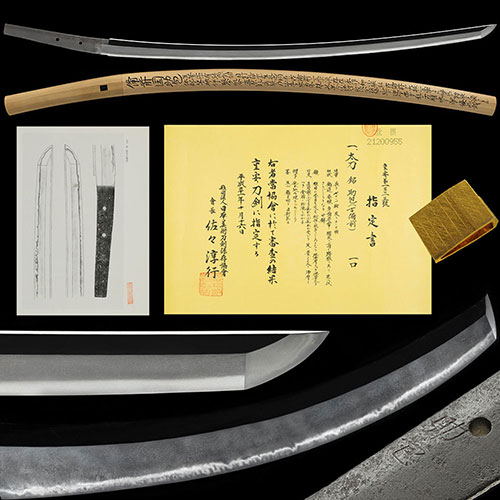
助包 太刀Sukekane Tachi
No.114622銘 助包 古備前生ぶ茎太刀 平安末期元暦頃 小丁子小乱れ足葉頻りに入り金筋掛る古雅で超健全な傑作刀 二尺三寸一分Mei Sukekane Kobizen Ubu-Nakago Tachi, Late Heian period, around Genryaku period, Small-Chouji and Small-Midare, There are Ashi and You frequently, Kinsuji-kakaru, An elegant and extremely Kenzen masterpiece sword 70.0cm
お問い合わせAsk
- 銘表Mei-Omote
- 助包助包 Sukekane
- 登録証Registration
- 福岡県 Fukuoka 昭和52年11月17日 11/17/52(Showa)
- 時代Period
- 平安末期元暦頃 Late Heian period, around Genryaku period
- 法量Size
-
刃長 70.0cm (二尺三寸一分) 反り 2.1cm
元幅 3.2cm 先幅 2.2cm 元重 0.58cm 鎬厚 0.65cm 先重 0.41cm 鋒長 3.1cm 茎長 19.1cm 重量 645gHachou 70.0cm (二尺三寸一分) Sori 2.1cm
Moto-Haba 3.2cm Saki-Haba 2.2cm Moto-Kasane 0.58cm Shinogi-Thikess 0.65cm Saki-Kasane 0.41cm Kissaki-Chou 3.1cm Nakago-Chou 19.1cm Weight 645g - 国Country
- 備前Bizen
- 姿Shape
- 鎬造、庵棟、身幅広く、反り深く、腰反り踏ん張りつき、中鋒。Shinogidukuri, Iorimune, Wide Mihaba, Deep Sori, Koshizori-Funbaritsuki, Chu-Kissaki
- 鍛Kitae
- 板目肌に、杢目肌交じり、地沸微塵に厚くつき、地景よく入り、乱れ映りたつ。Itamehada, Mixed Mokumehada, Jinie entered fine and thick, Chikei entered frequently, Midare-Utsuritatsu.
- 刃文Hamon
- 直刃調に、小乱れ・小丁子・角張る刃など交じり、足・葉頻りに入り、小沸深くつき、金筋・砂流しかかる。Suguha-style, Small-Midare, Small-Chouji and Mixed Kakubaru-Yaiba, There are Ashi and You frequently, Small-Nie entered deeply, Kinsuji and Sunagashi-kakaru.
- 帽子Boushi
- 乱れ込んで焼き詰めごころ。Midarekonde-Yakitsumegokoro.
- 茎Nakago
- 生ぶ、先切、鑢目切、目釘孔二。Ubu, Sakikiri, Yasurimegiri, Mekugiana are two(2)
- ハバキHabaki
- 金色絵一重。Single KinIroe.
- 説明Drscription
- 備前国では、吉井川流域で産出される良質な砂鉄を原料とし古くから鍛刀が行われたが、平安時代後期から鎌倉時代初期の刀工を総称して古備前派と称する。平安中期永延頃の友成を祖とすると伝え、他著名工には、正恒・包平・助包などがいる。古来より贈答用、奉納用に珍重され、江戸時代においてはそのほとんどが大名家ないし寺社に納められていた。助包は、平安末期元暦頃の刀工で、是助の子と伝え、左近将監を名乗り、桜丸・抜丸・祢祢丸の作者と云う。この刀は、反り深く、腰反り踏ん張りつき、先伏せごころとなる平安時代の凛とした姿に、杢目よく交じる板目肌に地沸微塵に厚くつき、地景よく入り、乱れ映りたつ地鉄に、直刃調に、小丁子乱れに小乱れ・角張る刃など交じえ、総体に逆がかり、足・葉頻りに入り、小沸深くよくつき、金筋細かく掛り、古雅で見所の多く、尚且つ超健全な傑作である。In Bizen Province, swords have been forged since ancient times using high-quality Satetsu(Iron sand) produced in the Yoshii River basin, and swordsmiths from the late Heian period to the early Kamakura period are collectively known as the Ko-Bizen school.
It is said that the founder of this swordsmith group was Tomonari, who lived around the time of Eien in the mid-Heian period, and other famous swordsmiths include Masatsune, Kanehira, and Sukekane.
Since ancient times, they have been prized as gifts and offerings, and in the Edo period, most of them were given to feudal lords or temples and shrines.
Suketsune was a swordsmith around the Genryaku period in the late Heian period, said to be the son of Zesuke, and calling himself Sakonnoshogen. He is said to be the maker of Sakuramaru, Nukemaru, and Nenemaru.
This sword has deep Sori, Koshizori-Funbaritsuki, The dignified appearance of the Heian period that becomes Sakifusegokoro, Mixed Mokume with Itamehada, Jinie entered fine and thick, Chikei entered frequently with Midare-Utsuritatsu Jigane, Suguha-style, Small-Choujimidare and Small-Midare, Mixed Kakubaru-Yaiba, an overall Sakagakari, There are frequently Ashi and You, Small-Nie entered well, Kinsuji entered finely detailed lines, an elegant appearance, with many highlights, and an extremely Kenzen, A masterpiece.


